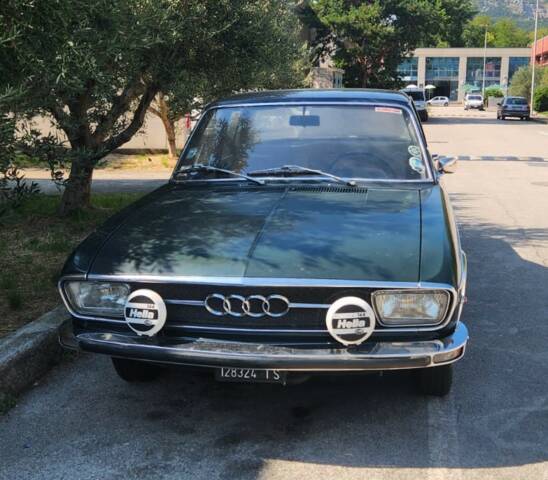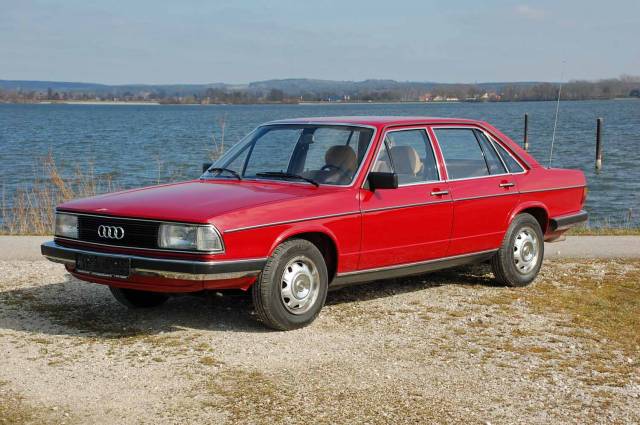Audi 100 classic cars for sale
The Audi 100 stands for four generations of upper mid-range engineering from 1968 to 1994, marked by progressive technology, distinctive design lines and a range from four-cylinder saloons to powerful V6 luxury versions. The car's model history reflects the transformation of Audi into a prestige brand. Variants from standard saloons to Avant estates and Coupé S keep the 100 in demand across enthusiasts and collectors alike.
Search results

1970 | Audi 100 LS
Auto di famiglia da 3 generazioni

1980 | Audi 100
Automatik mit H-Zulassung seit über 40 Jahren im Erstbesitz
History of the Audi 100
The Audi 100, launched in 1968, initiated Audi's push into the upper mid-size segment, and it quickly became the company's most significant model throughout the 1970s and 1980s. The first generation (C1) established a reputation for front-wheel drive and subtle, functional aesthetics. As production advanced, each generation introduced innovative features such as a five-cylinder engine in the C2 and a world-beating aerodynamic body in the C3. The Audi 100’s longevity and international reach—including notable export versions to the USA as the Audi 5000—demonstrate its strategic importance to the brand. In 1994, the 100 evolved into the Audi A6, closing an era that had fundamentally changed Audi’s image and standing in the market.
Model Series and Evolution
Produced in four generations: the C1 (1968-1976), C2 (1976-1982), C3 (1982-1990), and C4 (1990-1994), the Audi 100 continually redefined its class. The C1 debuted with sober four- and two-door saloons. The C2 introduced larger bodies and, from 1977, the legendary five-cylinder engines—as well as the first Avant (estate) model. The C3 became a technological flagbearer with its galvanised panels and low drag coefficient (Cd 0.30), available as both saloon and Avant. The final C4 generation brought the model in line with luxury-class expectations with V6 engines and comprehensive comfort features. Unique variants include the Coupé S (1969-1976) and the C3-based Audi 200, which further souped up the 100 format. The line progressed naturally into the Audi A6 after 1994.
Highlights and Unique Features
Across its four generations, the Audi 100 set standards for its segment. Early models impressed with their durable four-cylinder engines and robust construction. The C2’s five-cylinder engine, advanced for its era, is highly regarded for its smooth performance. The C3's full-galvanised bodywork significantly improved longevity, combating corrosion—a rare solution in mass production at the time and a key feature on well-preserved examples today. Equipment from velour upholstery and air conditioning to electric windows and sunroofs enhanced appeal. Later C4 models stood out for their high-quality interiors and technological sophistication, including V6 powertrains and reduced body panel gaps, reflecting Audi's increasing attention to luxury. Sought-after Coupé and Avant models add variety, while classic details such as double round headlights and original Chrom trims highlight the era’s design priorities.
Technical Data – Models and Engines
Special Editions and Collectible Variants
Two variants stand out for collectors: the Audi 100 Coupé S (1969–1976), with only around 30,687 produced and highly distinct styling, and the Avant variants for practicality. The Audi 100 Avant Duo, an experimental hybrid shown in 1990/91, paved the way for future electrification at Audi. Market-specific editions (like US models with larger bumpers) and rare original equipment or dealer packages (e.g. Tresser accessories, Diplomat models, special colours like Delft Blue or Marathon Blue) increase interest among enthusiasts. Early unrestored cars, or those with the coveted H registration, provide extra value for collectors.
Weak Spots and Common Issues
Buyers should inspect early Audi 100s, especially those built before comprehensive galvanisation (pre-1986), for corrosion in wheel arches, sills, and floors. Drooping headliners, worn suspension joints, rubber bushings, and age-dependent drivetrain and electrical system wear are typical. Some Coupe S-specific spares can be challenging to find. Later models benefit from improved rust resistance and more robust engineering, but regular maintenance of timing belts, injection systems, and brake hydraulics (dual-circuit, disc/drum set-ups) remain vital. Well-kept examples have a reputation for long service, while Limousine versions enjoy strong community and spare parts support.
Engine, Performance, Transmission and Handling
Driving an Audi 100 delivers balanced handling and comfort, reflecting its purpose as an upper-middle-class saloon. Four-cylinder engines provide durability and economy; the five-cylinder units, from the C2 onwards, deliver a distinctive, refined character. V6-powered C4 models present increased smoothness and power. Both manual and automatic transmissions were available, adapting to a range of preferences. Period safety equipment includes dual-circuit hydraulics, disc front brakes and, in later models, more sophisticated side impact protection. The ride remains composed and motorway stability is a hallmark of the chassis, with refinement improving in each generation. Popular variants include the Audi 100 C1 (robust and most available), the C2 with the notable five-cylinder setup, the C3 (Typ 44) for its all-galvanised body, and C4 versions for luxury and V6 power. The Coupé S has strong enthusiast appeal for its rarity and style.
Interior, Comfort, Exterior and Design
The Audi 100’s restrained styling is a product of its era—early models feature clean, classic lines, double round headlamps and chrome details inside and out. The interior is spacious, with high-quality materials: velour, optional leather, and bespoke wood applications distinguish upscale versions. Early models often have unique steel or Ronal wheels with full covers. From the C3 generation, Audi introduced fully galvanised bodies and progressed to tighter tolerances and reduced panel gaps on the C4. Accessories such as sunroofs, original radio equipment (Blaupunkt, Becker), air conditioning, cruise control, and even rear sunblinds were available depending on trim level. Early special colours and options for electric windows, heated seats, and elaborate sound insulation added to the comfort and exclusivity of later models.
Other Noteworthy Features
Audi 100s built for the US market differ in their larger aluminium safety bumpers and various electrical accessories. Many examples survive with full documentation, service books, and even original toolkits. Early models with the historic H plate are insurance bargains in Germany, and documentation such as Classic Data valuations is often linked to well-cared-for examples. A strong enthusiast network supports limousine versions, and specialist suppliers exist for rarer Coupé S parts.
Summary – Audi 100 classic cars overview
The Audi 100 forged Audi’s path into the executive car market, with a model range spanning over 25 years and offering everything from durable four-cylinder saloons to innovative five- and six-cylinder powertrains. Its robust engineering, rust protection in later generations, and luxury features make it a practical, comfortable classic to own and drive. Early Coupé S and Avant models are now especially sought after, while Limousine variants offer reliability and accessibility. Genuine examples with history, original features, and low corrosion are increasingly prized among enthusiasts.

